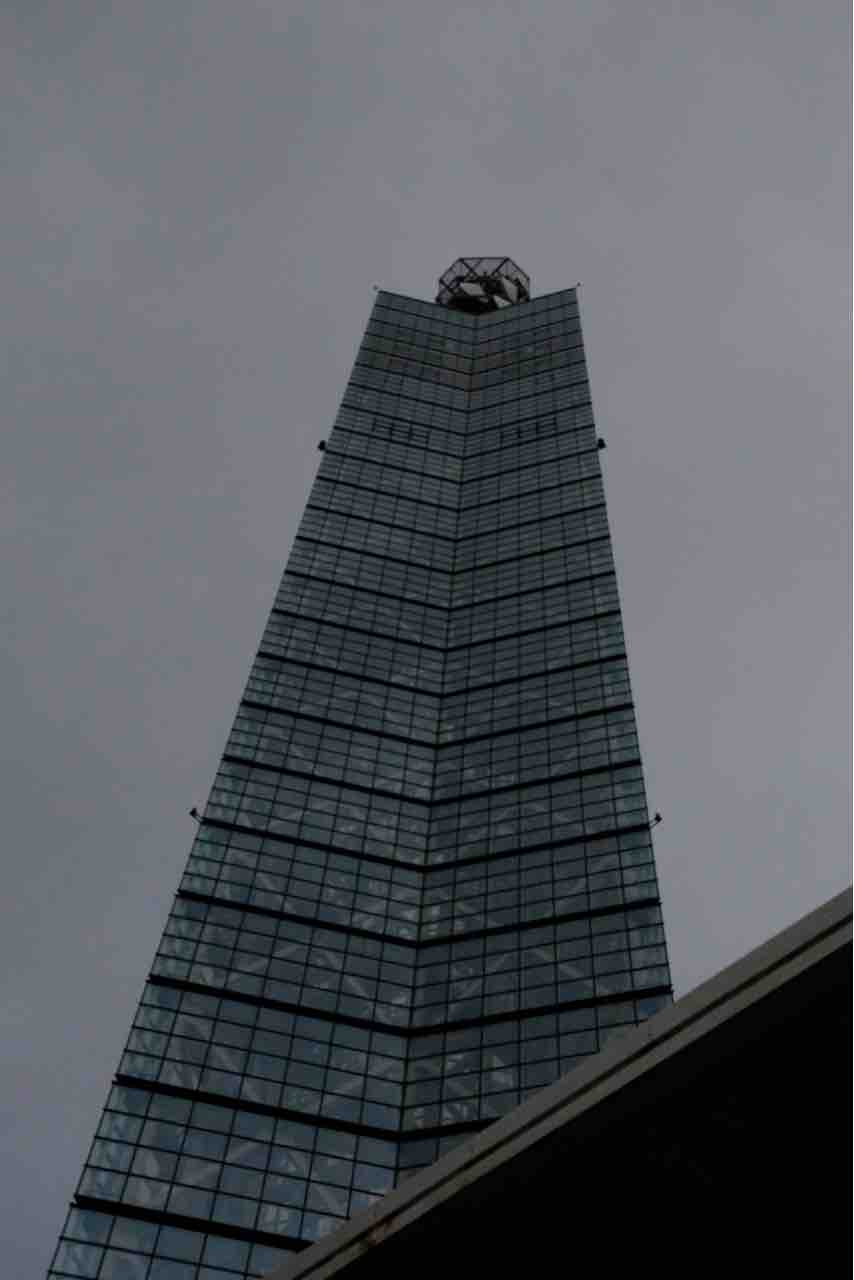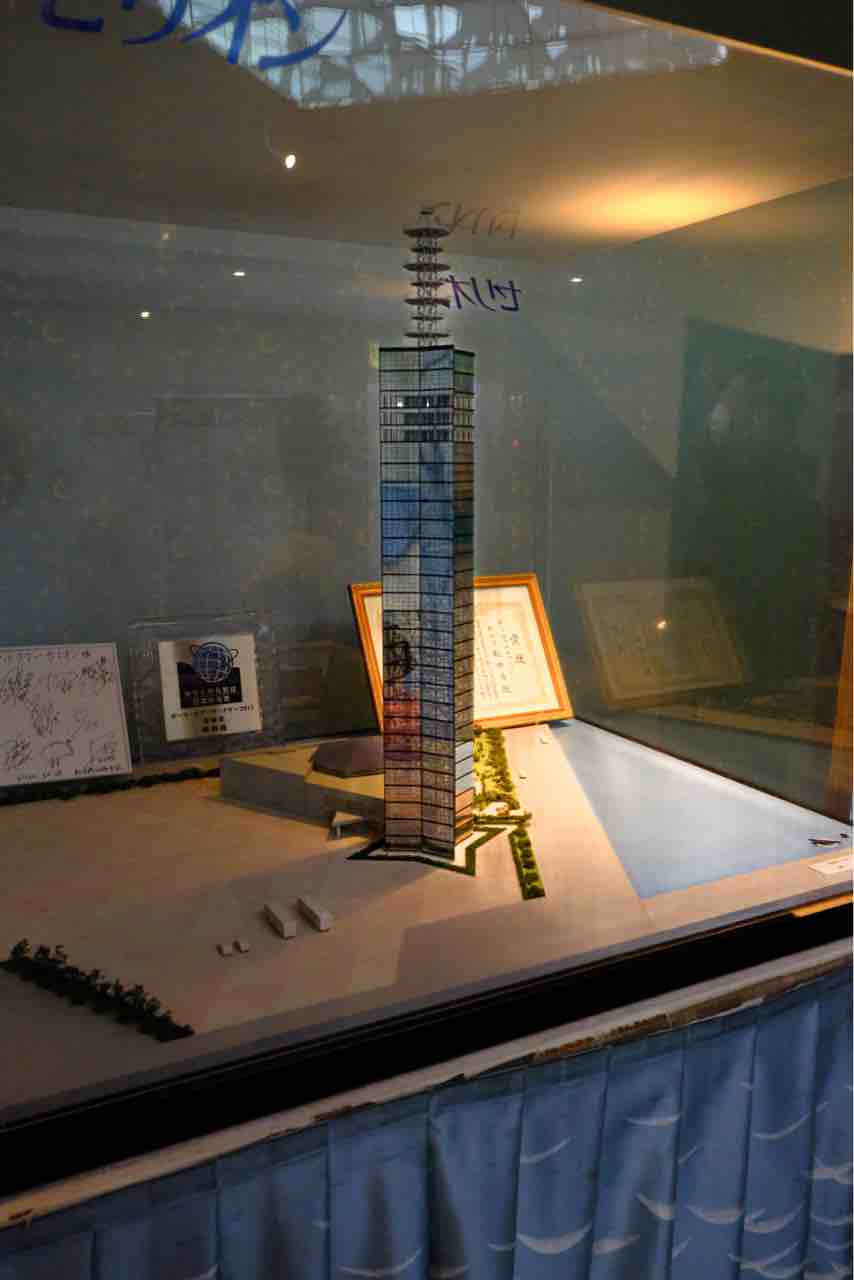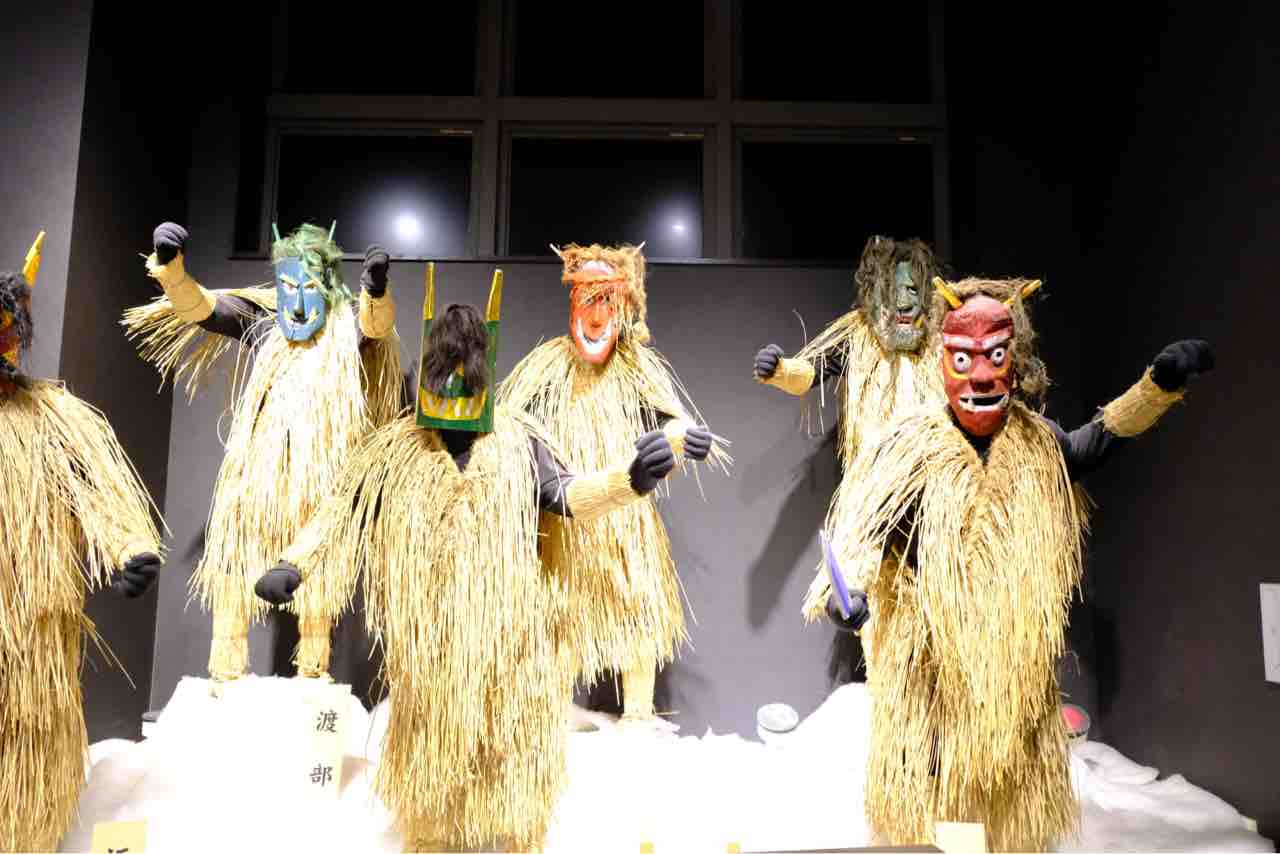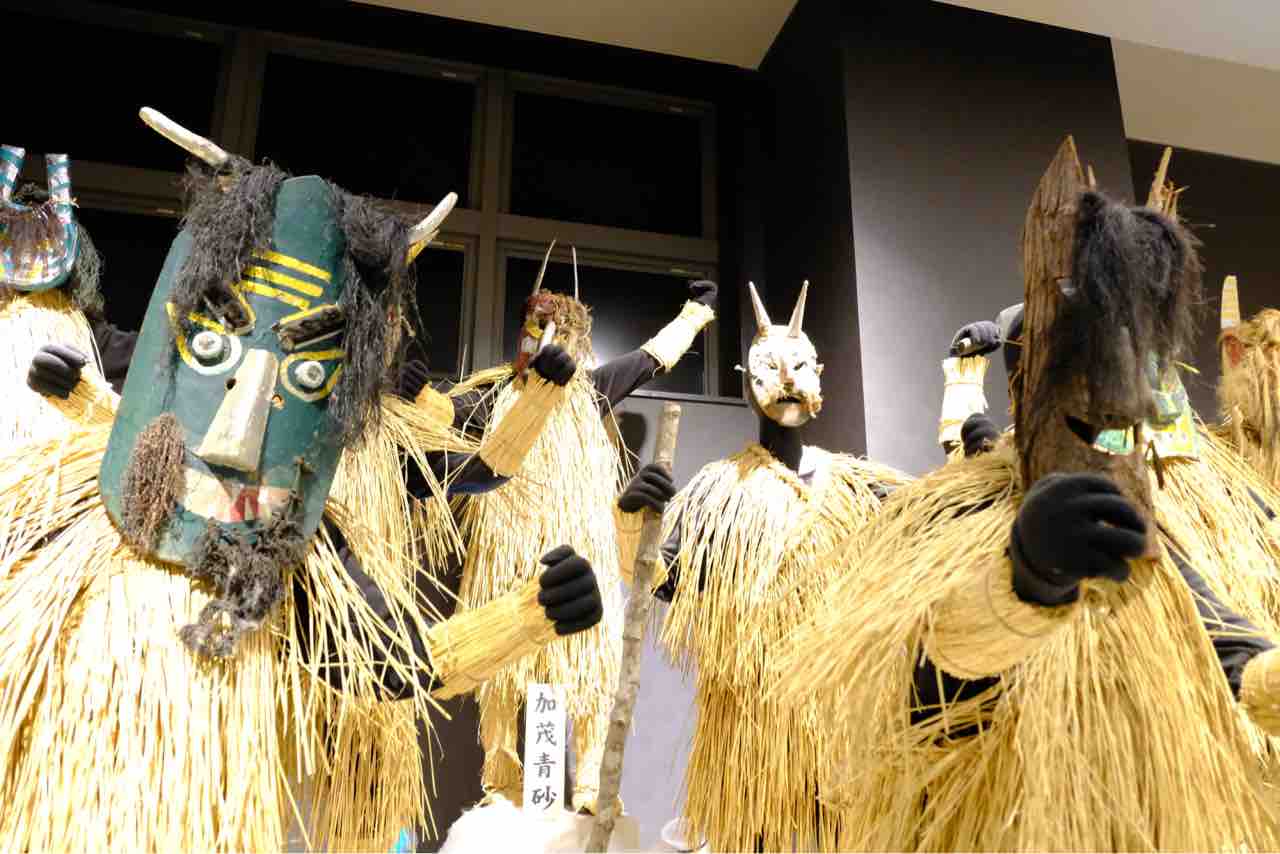JR男鹿線(男鹿なまはげライン)
秋田駅、それがこの物語の幕開け。

昨年、手にしたゲーム、「秋田・男鹿ミステリー案内 凍える銀嶺花」に触発され、なまはげに逢いたい一心で、年の瀬の秋田へと足を運んだというわけである。
北国の冬の寂しい景色は、シティーボーイの僕にとってはまさに憧憬、心は躍っていた。
そして、E6系の真紅のボディがテンションをさらに上げてくれる。
テンションの上がり切った僕は新幹線の中ではしゃぎまくり、秋田駅に降り立った時にはもう喉もからから。
こんな時、欲しいのは酒の一杯。そうだ、酒を飲もう。
そう思い立ち、秋田の夜に酒場を求めて繰り出した。それが、僕らの「捜査会議」の始まりだった。

秋田駅からそう遠くないところにある「秋田長屋酒場」にやってきた。
このお店、実は、ゲーム内に登場した「秋田酒場」のモデルになったところなのだ。
ゲームの中では、主人公の刑事が捜査の中で集めた情報を、この店にやってきて秋田の美味いもんをつまみながら整理するシーンがあるのだ。
明日の男鹿への旅に備えて、僕らはここで、「捜査会議」を開くことにした。まあ、実際の捜査とは違うけど、旅の計画を練るのもまた一つの冒険である。
すると・・・・・・

驚くべきことに、店の前に、なまはげが仁王立ちしているではないか。
いや、待てよ、君はなまはげなのか、仁王なのか、どっちなんだ?
などと、土地の守り神に対して不遜なジョークを心の中でつぶやきながら、入店するのだが。
店の入り口はすごく低くなっている。
それはもう驚くほど低い。
腰の高さほどの引き戸を屈みながら通るのだ。
なんとも言えない独特の入り口で、背中が「グキリ」と嫌な音を立てたが、
もうすぐ美味い酒が飲めるという期待感で、気づかないフリを決め込んで、さっそく店内へと潜入した。
通された座敷に着席すると、店員さんからおしぼりのサービス。
ゲームをプレイした人ならご存じ、おしぼりは”しゃっこい”のと”あつい”のから選べる。
僕は迷わず「あっつ~い」おしぼりを選んだ。そしていつものごとく、オヤジオイリーな肌をゴシゴシと拭き上げた。
なんとも清々しい瞬間だ。

ハタハタやきりたんぽなど秋田の地の物と、それに、秋田の地酒も豊富。
ちなみにこの店の向かいには菅久酒店という酒屋さんがあって、都内ではなかなか手に入らない秋田の銘酒が手に入る。
僕も嫁さんも菅久酒店で、日本酒の4合瓶を二人で7本も購入して、自宅へ送ることにしたんだ。
翌日、秋田市のホテルを出て、観光をスタートした。目指すはポートタワーセリオンだ。

これでもかというくらいの曇天模様の空の下、ポートタワーセリオンに到着。
秋田県は日照時間が全国一短いっていうのは、ほんとうなのかな。
そしてなんだか、めちゃめちゃ風が強くて顔が痛い。
ちなみに、このセリオン、ゲーム中ではなぜか「オリオン」という名前になっていた。
なんだか沖縄の風を感じるね。
ひとまず、セリオンの展望台から秋田市街を一望できるというので、さっそく登ってみることにした。
エレベーターを探していると・・・

これはまさに俺の好みにピッタリなセリオンの模型じゃあ~りませんか!
うーむ、これはバッチリ1/150スケールのNゲージサイズ!ちょうどいい大きさじゃないか。
我が家の鉄道模型レイアウトに置きたいもんですな!あ、でも狭いから無理か~!
とか言いつつ、エレベーターで展望台へ。

さっそく目に飛び込んできたのは秋田港駅。なんとも言えぬ鉄ちゃんの感性、さすがである。
この秋田港駅、貨物駅なんだが、なんとクルーズ船の乗客もちょくちょく扱うんだって。

周りを見渡せば、曇天と海。
まさに日本海の冬景色といったところだな。
その日本海沿岸の強風をエネルギーに変えようと、秋田港周辺には風力発電のための巨大な風車が点在している。
沖の方の風車はまだケーブルが繋がっておらず、電力の供給は先になるそうだ。
展望台を後にし、続いてやってきたのはセリオンに併設の休憩所だ。

そこで、セリオン名物うどん・そば自販機を発見!!!
あーこれ知ってるぞ!!!
テレビで佐○木希が「美味しいんですよ〜」とか言っていた気がする。

残念ながら補充中であったが、近くの売店コーナーでカップ麺形式で販売されていたのでお土産に一つ買ってみた。
気になるお味のほうは・・・うん、まあこんなもんかな( ^ω^)・・・
希ちゃんの嘘つき〜っ!
セリオンを後にし、僕らの一行は男鹿方面へ向かう。

日本海の荒々しい海を横目に、強烈な風を受けつつすすんでいくと、ここにも巨大な風車が立ち並ぶ。

なんかいる!!!

男鹿総合観光案内所では巨大なナマハゲがお出迎え。こちらもゲームに登場した。

道の駅オガーレで休憩中に踏切を発見した。
こちらは、旧男鹿線船川港の船入踏切の遺構みたいだが、どうやら元あった場所から移設してきたらしい。

そのオガーレの近くに津波避難施設があったんだ。その名も「アガーレ」
秋田県人はギャグセンも高めである。
オガーレを後にして、鵜ノ崎海岸を進んでいく。
この辺りは夏になると海水浴客で賑わうという。
なんでも、遠浅の海は秋田の秋田のウユニ塩湖って言われているんだそうだ。
それはちょっと盛り過ぎのような気もするが。
などと不遜なことを考えながら、海を眺める。
ウユニ塩湖だけでなく、全国に数箇所あるゴジラ岩と呼ばれる岩もこの辺りにあるそうである。
しかし、この日はあまりの強風でゴジラには近づくことを諦めた。
真冬の日本海、荒れ狂う海を見下ろしつつ山道を進むと、崖の上から水平線が丸く見える絶景である。
あまりの絶景に見惚れてしまい、写真を撮り忘れた。

男鹿水族館GAOでシロクマを見学し、館内にあるレストラン・フルットで昼食休憩。
僕は、秋田名物の海藻、「ぎばさ」のラーメンをオーダーして、食べてみた。
う、美味い!!
不意を突かれた。正直、予想の3倍も美味かった。
いやほんとに、自販機うどんの1000倍は美味かった。

北緯40度線上にある入道崎灯台に来た。
冬の灯台、なんて美しいんだろう。
激しい風の中、そびえ立つその姿は、孤独な詩人のようだ。
自然の荒々しさと、そこに立つ人間のちっぽけさが交錯する。
気づけば一筋の涙が頬を伝った。これはまあ、風が強すぎるせいだが…
そして、ついに僕たちはたどり着いた。なまはげに会える場所に。
 >
>
なまはげ館!そう、ここがその名所か。
なまはげの面々が、館内にずらりと並んでいる。それぞれが異なる表情やポーズで、迫力を醸し出している。
・・・はずなのだが、年末のこの時期はなまはげたちは繁忙期。
大晦日の夜には、なまはげたちが家々を廻るため、実際に集落で使用中のなまはげもあり、一部のなまはげ面は写真にすげ替わっていた。

なまはげと言えば赤や青の鬼のような顔をしたイメージが一般的だが、実際には緑や茶、銀といった色とりどりのなまはげが存在する。
彼らの多様な表情と色彩は、地域や伝統によって異なり、その地域独自の文化や風習を反映している。

可愛いらしいものや、笑えるもの、不気味なもの、その意匠はさまざまだ。

なまはげ、その名の由来は「ナモミ剥ぎ」の転訛であるとか。
ナモミというのは、冬の寒い時に火に当たってばかりいると皮膚にできる火型(紅斑)のこと。
つまり、仕事もせずに怠けて囲炉裏にばかり当たっていると、なまはげが来て包丁でナモミを剥ぎ取ってしまうという、一種の戒めとして伝えられてきた。

なまはげの相にもいろいろ好みがあるが、僕のお気に入りはこちらのなまはげさん。

そして、なまはげ館に併設の男鹿真山伝承館では、実際になまはげが家に訪れる様子を見学できる。
これがまた素晴らしい名演技である。見学の子供たちは、泣き叫ぶ子や固まる子と反応はさまざまだが、大人はなまはげのコントに大笑い。圧巻だった。

なまはげ観光の締めくくりに、なまはげ館からほど近い真山神社を訪れる。

雪の中で厳かな雰囲気が漂っている。

なまはげにゆかりの神社らしく、大きな包丁が奉納されている。
国鉄土崎工場鍛治職場の文字。これは立派な鉄道遺産だ。
思いがけない場所に、鉄道愛好家の心をくすぐる要素が潜んでいるものである。
そして、日が沈みかけている。お腹もペコリ。
今夜は男鹿に宿泊することになった。美味しいお酒が待ち遠しい。
宿についてひと風呂浴びる。今日は寒かった。
そして待望の飯!!!男鹿名物、石焼き鍋というものをいただく。

この石焼鍋の作り方、一風変わっている。
まず、木桶に入った味噌汁に、蟹や魚の魚介類を入れていく。

そこに真っ赤に熱された石をグワっと放り込む!すると味噌汁がぐらぐらと煮えたぎり、魚介の良い香りがあたりを包み込んだ。

この出汁、最高じゃないか!酒の締めにも最高だ。
夜深くまで、地酒をたっぷり堪能した。

最後に、男鹿線を走るEV-E801系ACCUMの乗車体験で締めくくろう。
あれ、おっちゃんがなんか言っている。頭挟まるで〜
今回は、ゲーム「凍える銀嶺花」の聖地巡礼の旅をお送りした。お楽しみいただただろうか。
2023年もよろしくお願いします!!
令和にもなって、こんな辺境の個人ホームページなんて誰も読んでいないとは思いますがね!